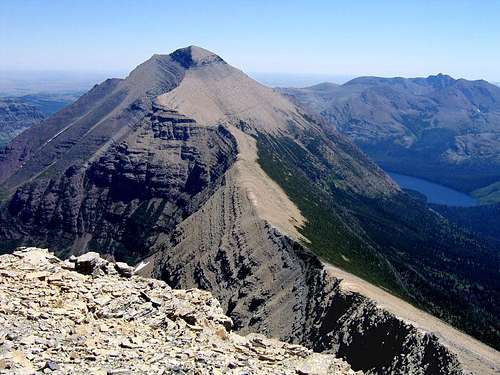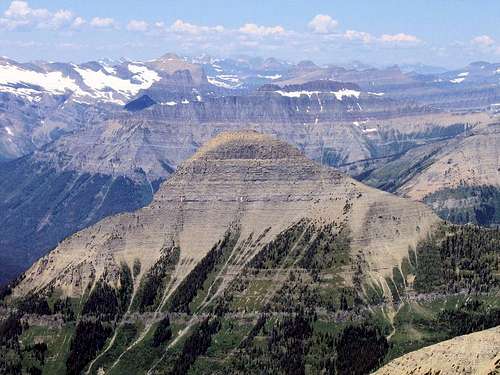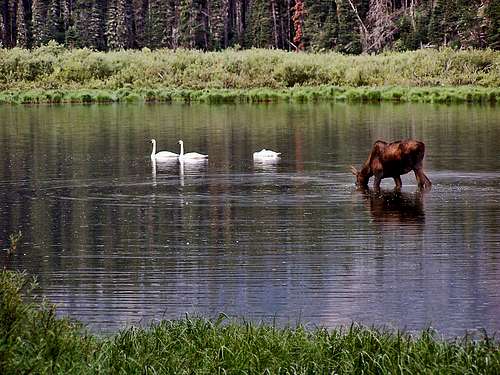-
 35360 Hits
35360 Hits
-
 95.83% Score
95.83% Score
-
 55 Votes
55 Votes
|
|
Mountain/Rock |
|---|---|
|
|
48.49800°N / 113.465°W |
|
|
Hiking, Scrambling |
|
|
Spring, Summer, Fall |
|
|
9225 ft / 2812 m |
|
|
INTRODUCING THE MOUNTAIN
DAWSON PASS (7,598')
Three major trails head west from the Two Medicine Campground, leading to—respectively, from south to north—Two Medicine Pass, Dawson Pass, and the Pitamakan and Cut Bank Passes (same trail, with the two passes only separated by a half mile or less). Of these three the route to Dawson Pass, at 6.3 miles, is shortest, following the north side of Two Medicine Lake (5,164')—and having nice views of Mount Henry, Mount Ellsworth, Never Laughs Mountain, Painted Tepee Peak, Grizzly Mountain, and the occasional tantalizing glimpses of Mount Rockwell, poking out from behind Sinopah Mountain—which for a while dominates everything at the west end of the lake—circumventing the south slopes of Rising Wolf Mountain, passing just north of Sinopah, then eventually rising to its saddle, anchored on the south by Mount Helen, and on the north by Flinsch Peak. During this trek the terrain is dominated more and more by the cliffs of, first, Sinopah and Rising Wolf, gradually giving way on the south to the sheer face of Helen, and then the first unassuming views through the trees of the barely discernable horn of Flinsch Peak. The trail climbs steadily, with Flinsch coming more and more into focus, the last bit of elevation gain to the pass leaves the forest behind, the scene opens as it climbs, Flinsch is now visible in its entirety, and then you reach the pass... ...and if you're like me, at that point you stop, not even thinking to take off your pack; stop, and just look. And say something inspirational to fill the moment, like a softly spoken, "Wow..." Or, even after a lifetime of seeing, "...ohmygoodness these mountains are...BIG." Then (if you're like me) you remember you have a camera, have enough sense to drop your pack, and start running from one end of the pass to the other, because every few steps seems to bring something even more—or at least as worthy as what was just a few feet ago—wonderful of which to take a picture. Dawson Pass does that to you. Cresting its shoulder brings an in-your-face confrontation with the likes of—these all rising out of the Nyack and Coal Creek Valleys thousands of feet below—a (really) massive (and this is the first thing to grab your attention) Mount Phillips, Mount Saint Nicholas, Battlement, Vigil, Lone Walker, Pinchot, Glacier's second highest summit in Mount Stimson, Blackfoot Mountain, standing huge and glaciated in the distance, while closer is relatively unknown Tinkham Mountain...and it is all there for the taking, on a gently rounded saddle between Mount Helen and Flinsch Peak. And still, up and away in the near distance: the horn of Flinsch Peak. CLIMBING FLINSCH PEAK An excellent shot showing Flinsch's rotten summit cliffs—always test steps and hand holds An excellent shot showing Flinsch's rotten summit cliffs—always test steps and hand holdsCAUTION! Watch those below you—rock fall can be dangerous! The view and climb—of course—don't stop at Dawson Pass, as there is still over 1,600 feet to the summit, which, while not by any means a difficult ascent—except care must be taken on the summit cliffs—is not as close as it appears. At first the trail seemingly heads up the peak, but after maybe a quarter mile drops down off the pass to eventually, after having skirted the west faces of both Flinsch and neighboring Mount Morgan, join the Cut Bank/Pitamakan Trail between those two passes, and so work its way back to the Two Medicine Campground. (This "loop" is often done as a one-day outing, a long—but nice—trek with no off-trail climbs. Interestingly, while on Flinsch Peak we watched several parties of hikers crest the pass, then continue on, presumably doing just that; we were—and it was a nice day—the only ones on the mountain.) Where the trail leaves the ascent, simply keep heading up the peak. (Note: The climb is probably no more than a GNP rating of Class 3, although the cliffs surrounding the summit are quite rotten, and falling-rock awareness is certainly necessary. While some of the moves will raise your concentration level a bit, the cliffs don't offer up the kind of exposure which would take them to a Class 4 rating.) Gradually, the vista fills with even more mountains. The climb brings into view such as Mount Rockwell and Grizzly Mountain, points south of them, back more easterly into the Two Medicine area, and the entire west ridge of next-door Rising Wolf Mountain. (Rising Wolf and Flinsch are often done as a pair, making for a long, but extremely rewarding, day—Rising Wolf almost always is done first, see that page for an explanation as to why. This day, we chose to do Flinsch and Helen as a pair—another nice, "extremely rewarding" outing!)
The higher on the mountain, the less solid the rock becomes, at times being little more than a scree ascent. All in all though, it's not too bad, and when the summit cliffs are reached, work your way around to the right so as to avoid potential technical climbing; the route is relatively obvious, and scrambling the last bit to the summit poses no difficulty. A word of warning: while working through the cliffs, the rock is quite loose, so watch foot and hand holds, at the same time taking care to not push anything down on those below you. Then, enjoy the summit! Photographic details for climbing Flinsch Peak can be found in Volume Two of Climb Glacier National Park. It can be ordered at Climb Glacier National Park. NOW, ABOUT THOSE SUMMIT VIEWS....
THE RED TAPE, WILDLIFE, & CAUTIONS SECTION
BLACKFEET INDIAN RESERVATION
GETTING THERE
Map of Waterton/Glacier International Peace Park WHEN TO CLIMB, & CLIMBING CONSIDERATIONS
Because of the nature of the rock, there are special considerations regarding climbing in Glacier National Park, and grading systems unique to the park have been developed by both J. Gordon Edwards and the Glacier Mountaineering Society. Anyone doing more than just "trail" hiking in this part of the Rockies should read the excellent and important information put together by Fred and Moni Spicker. Much—if not most—of the rock in GNP is sedimentary and rotten, and you need to know about it: Glacier National Park Rock & Grading Systems. CAMPING & LODGING
The community of East Glacier Park is within easy driving of Two Medicine Lake (approximately 20 minutes), and has several restaurants and motels, as well as an RV park which also caters to tenters. And if your credit card is gathering dust, East Glacier Park is also home to the (really nice) Glacier Park Lodge. CURRENT MOUNTAIN CONDITIONS/WEB CAMSWeather page—an overview, plus current conditions and forecast This is the New NPS Web Cam Page.
EXTERNAL LINKS/ADDITIONAL INFORMATION/ITEMS OF RELATED INTEREST
In TributeOn March 1, 2011, Vernon Garner, Saintgrizzly, left us after losing a bold, inspiring fight against pancreatic cancer. Or maybe he won, for he is at last free of his pain and has "shuffle[d] off this mortal coil."Vernon was an important contributor on SummitPost, but beyond merely making good, informative pages, he actually inspired many who read his work. No one put more work into his or her pages than Vernon did, and many of those pages, especially those related to Glacier National Park, the place he loved above all others, are works of art in both the writing and layout. More than one person has wanted to visit Glacier or go back to Glacier largely due to what he shared about that magnificent place. Many people on SP counted Vernon among their friends, and many more saw him as one of the best, one of those who exemplified the spirit of this site. He was one of the best of us, he will be missed, and he will not be forgotten. As a tribute to him, Vernon's pages will remain in his name. Any member who sees a need for an addition or correction should please contact site management via the "Send PM to the Elves" feature. Rest well and climb on, Vernon. |
































